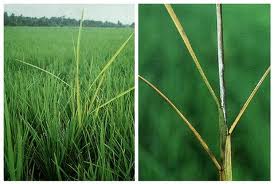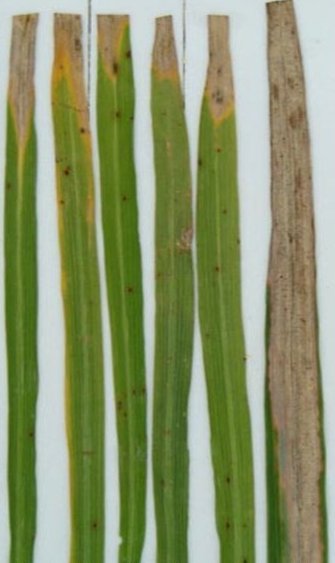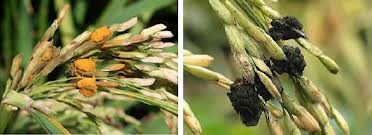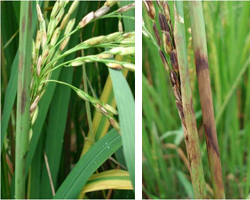
Fig 1.1
Crop: Rice
Scientific name : Oryza sativa L.,
Common / Local Name : Dhaan / Bhath
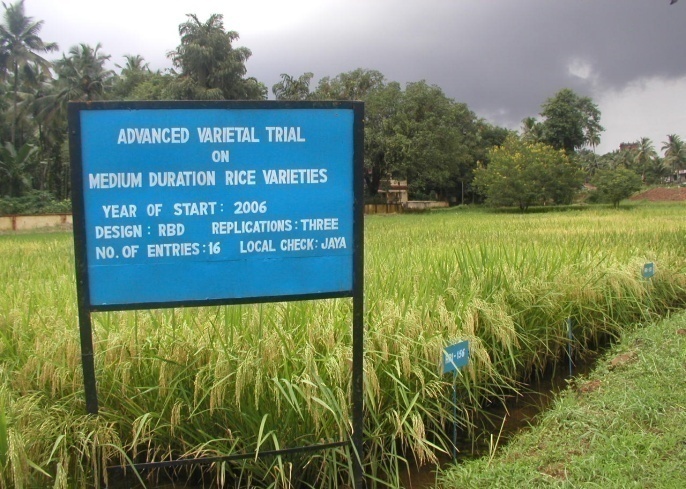 Fig 1.2
Fig 1.2
 Fig 1.3
Fig 1.3
Rice is the staple food crop of Goa. The crop is cultivated over an area of 42,973 ha with a production of 1,55,818 mt annually. The average productivity of the crop is about 3,399 kg/ha. The crop is cultivated in three different topographical situations i.e. rainfed uplands (Morod), rainfed low lands (Kher) and coastal saline lands (Khazans). The crop is being cultivated both during kharif (Sod) and rabi (Vaigon) seasons, with an area of approximately 67 % and 33%, respectively. The average productivity of rabi season is relatively higher (4052 kg/ha) as compared to kharif season (3781 kg/ha). Average land holding size in Goa is relatively less (95% less than 1 ha) and that too fragmented. Further, the socio-economic situations prevailing in the State and non-availability and high cost of labour, lack of mechanization, threshing and processing facilities including marketing infrastructure are threatening the cultivation of this major food crop.
Ploughing should start with first shower of monsoon to a depth of 15 cm with the help of power tiller or mould board plough. Apply well decomposed FYM (10 MT) after the first ploughing. This operation is to be completed atleast 15 days before sowing of the seed. Green manures (finely chopped) like Glyricidia (grown on bunds /fences), Dhaincha etc. or any biomass from major weeds on uplands like Eupatorium be incorporated as per availability. Proper leveling and bunding should be ensured for better water and soil conservation.
Direct seeding either by dibbling of seeds in dry soil at 20 X 15 cm spacing or plough sole placement before onset of regular monsoon is recommended.
Pre-germinated seeds can be broadcasted on a level surface after puddling and maintain a thin film of water.
In a transplanted crop, the seedlings need to be planted at the age of 21-25 days on a puddle soil with 3-4 seedlings/ hill at a spacing of 20 x 10 cm ensuring atleast 50 hills / sq.m. Shallow transplanting favours more tillering and consequently higher yield.
|
Rainfed shallow lowland ecology |
|
|||||
|
Category |
Variety |
Days to maturity |
Grain type |
Avg Yield (t/ha) |
Seed rate |
Photos |
|
Long duration |
Pusa-44 |
135 |
Medium slender |
6.5 ?7.0 |
50 kg/ha |
 |
|
Medium duration |
Karjat-3
|
120-125
|
Medium slender |
6.0 ?6.5 |
50 kg/ha |
 |
|
Naveen |
120-125
|
Medium slender |
6.0 ?6.5 |
50 kg/ha |
 |
|
|
Aromatic rice varieties |
PB-1121 |
130 - 135 |
Extra long grains |
4.5 ?5.0 |
40 kg/ha |
 |
|
Irrigated ecology |
||||||
|
1 |
Naveen |
120-125 |
Medium slender |
7.0 ?7.5 |
50 kg/ha |
 |
|
Coastal Saline Soils |
|
|||||
|
1 |
CSR-27 |
120 |
Medium slender |
3.5 ?4.0 |
60 kg/ha |
 |
|
2 |
CSR-36 |
135 |
Long slender |
4.0 ?4.5 |
60 kg/ha |
 |
Nutrient Deficiency and Its Management
Nitrogen


| Deficiency symptoms | Management |
|
|
Phosphorus




| Deficiency symptoms | Management |
|
|
Potassium 


| Deficiency symptoms | Management |
|
|
Sulphur
Deficiency symptoms 

| Deficiency symptoms | Management |
|
|
Zinc
Deficiency symptoms 


| Deficiency symptoms | Management |
|
|
Iron
Deficiency symptoms Management Boron
Management FYM @ 10 MT / ha or any other available organic / green manure can be incorporated 2-3 weeks before sowing. Apply Rock Phosphate @ 45 kg/ha atleast one week before sowing both as a source of phosphorus and as soil conditioner Recommended fertilizers:-100:50:50 kg NPK / ha. Apply all phosphate (P2 O5), 50% nitrogen (N) and 50% potash (K20) as basal dose at the time of sowing or transplanting. After 25-30 days, apply 25% nitrogen as first top dressing. Later, in another 20-25 days, apply balance 25% nitrogen and 50% potash as second top dressing. Weed the field and drain water wherever possible before top dressing. Type of fertilizer and its quantity can be chosen from any of the combination given below. Use of combination of straight fertilizers is economical, with better crop response. Sr. No. Type of Fertilizer Total Qty Basal dose Top dressing 1) a) Urea 217 109 54 54 2) Urea 174 66 54 54 3) Urea 174 66 54 54 4) Urea 109 --- 55 54 5) Urea 109 --- 55 54 6) Urea 109 --- 55 54 Although rice is a water loving plant, excess water will not be of much use for the crop as lack of drainage will reduce the yield of the crop. Proper leveling and bunding should be ensured for better water and soil conservation. A good puddling by churning the soil with water will favour better water management and inturn good crop growth. Weed infestation is a chronic problem in rice cultivation. The loss caused by weeds ranges from 30?0% including quality deterioration of the grain. The first 35?40 days of the crop is the critical period for weed competition.
The weeds can be effectively controlled by using Cono weeder (low cost manually operated interculture implement) in line sown crops with availability of thin film of water in the field.
Herbicide formulations like Butachlor 5 G @ 20 kg / ha or Benthiocarb 20 G can be mixed with water and blanket spray with high volume sprayer three days after sowing is recommended. Granular herbicides are convenient to apply as it eliminates the use of spray pump.
Alternatively, the selective herbicides like Benthiocarb 50 EC @ 3.0 litres / ha or Butachlor 50 EC @ 3.0 litres/ha or Pendimethalin 30 EC @ 3.0 litres/ha or Anilophos 30 EC @ 1.0 litre / ha can be used. Benthiocarb is preferred as it also has a post emergent effect on weeds upto 1-2 leaf stage besides killing germinating weed seeds.
Alternatively, mix the above formulation with 80-90 kg of fine sand and broadcast evenly in the field. For use of granular herbicides application, drain the water from the field.
In low lands, where there is standing water, broadcast Benthiocarb 10 G granules, a week after direct sowing or within 8 days of transplanting. Maintain 3-5 cm of water level in the field after granular application so that soil is under water but leaves are above water. Do not allow water to flow from one field to another. This controls a wide range of weeds for 30-35 days after application. However, if Cyperus and broad leaved weeds are present, spray 2,4, D @ 2.5 kg./ hectare about three weeks after transplanting or 4 weeks after sowing.
Larva feeds inside the stem causing drying of the central shoot is called ‘dead heart?in young plant.
Drying of the whole panicle is called ‘white ear?in older plants. Clipping the tip of the seedlings prior to transplantation to eliminate egg masses.
Collection and destruction of moths using light traps.
Avoid close planting and continuous water stagnation.
Release the egg parasitoid, Trichogramma japonicum on twice @ 5 cc/ha.
Spray Monocrotophos 36 SL @1000 ml/ha or Profenophos 50 EC @1000 ml/ha . Larvae cut the seedlings in large scale.
Severe infestation - cattle grazing appearance to the field.
They feed gregariously and march from field to field.
Deep ploughing the field in summer exposes the larvae and pupae
for predation by birds.
Kerosene oil may be poured into the stagnant water in the bunded fields (2 L kerosene per hectare).
Spray of chlorpyriphos 20 EC @ 2ml/ litre of water, 2.5 litres/ha or quinalphos 25 EC @, 2ml/ lites of water, 2.0 litres/ha or triazophos
40 EC @ 0.5 ml/litre of water, 1.0 litres/ha.
Dusting of chlorpyriphos 1.5 % D@ 30 kg/ha controls this pest.
The larvae roll the leaf in longitudinally and remain inside.
In a severely infested field the whole crop gives a sickly appearance with white patches. Removal of grass from field bunds.
Avoid excessive nitrogenous fertilizers.
Light traps to attract and kill moths.
Spray NSKE 5 % or carbaryl 50 WP 1 Kg or chlorpyriphos 20 EC 1250 ml/ ha. Caterpillars feed on green tissues of the leaves and leave become whitish papery.
Tubular cases around the tillers by cutting the apical portion of leaves.
Floating of tubular cases on the water. Drain the water.
Spray monocrotophos 36 WSC 500 ml / ha Blast is generally considered as the principal disease of rice because of its wide distribution and its destructiveness under favorable conditions. Rice seedlings or plants at the tillering stage are often completely killed. Heavy infections on the panicles are often detrimental to rice yields. Yield losses ranged from 30-70% depending upon the stage of infection. ?The fungus attacks all aerial parts of plant at all the stages of growth, although leaves and the neck of the panicle are more commonly affected.
?The fungus produces spots or lesions on leaves, nodes and different parts of panicles and the grain.
?The leaf spots are typically elliptical with more or less spindle shaped with reddish brown or dark brown margin. The centre of the spot is usually grey or whitish. Numerous spots on a leaf cause killing and drying up of the leaf sheath.
?When the node is infected, irregular black areas can be noticed in the nodes and the affected nodes may break up and all the plant parts above the infected nodes may die (node blast).
?In case of neck infection the stem below the ear head gets infection and turns into brown to black spots which may cover the entire stem. In early neck infection, grain filling doesn’t occur and the panicle remains erect like a dead heart caused by stem borer.
?In the late infection, partial grain filling occurs, small brown to black spots also may be noticed on glumes of the heavily infected panicle.
?Grow resistant varieties (IR20, Jaya, IR64). ?
Remove and destroy affected straw, stubbles and weed hosts. ?
Treat the seeds with biocontrol agents like Pseudomonas fluorescens @10 g/kg. ?Avoid closer spacing of seedlings in the field. ?Spray the crops with Ediphenphos (1ml/litre)/ Carbendazin(1g/litre)/ Tricyclazole (2g/litre)/ Iprobenphos (2ml/litre)/ Thiophanate methyl. Four to five sprays at 10 days interval may be needed for complete control. One at nursey, two during tillering stage and one to two during panicle emergence stage.
The disease has a worldwide distribution and it has been reported in all rice growing countries. In India this disease was one of the principal causes of the famous Bengal famine of 1942-43. ?In most conspicuous symptoms of the disease are on leaves and the glumes. Symptoms may also appear on the coleoptile, leaf sheath, panicle branches and more rarely on roots of the young seedlings and stem.
?Typical symptom is the development of numerous, dark brown, oval, about the size and shape of sesame seeds. They are relatively uniform and fairly evenly distributed over the leaf surface.
?The spots are brown with grey or whitish centre when fully developed. Young or undeveloped spots are small and circular and may appear as dark brown or purplish brown dots.
?In severe cases these spots may coalesce and cover the entire leaf. Black or dark brown spots appear on the glumes which contain large number of conidiophores and conidia of the fungus.
?Coleoptiles may become infected from diseased seeds cause seedling mortality.
?As the disease is seed borne, avoid seeds obtained from an infected crop for sowing.
?Treat the seeds with Thiram/ Captan @ 4g/kg or Pseudomonas fluorescens @10 g/kg.
?Spray the crop with Mancozeb (2g/litre)/ Ediphenphos (1ml/litre) as 500 ml/ Captafol (625g/litre). ?The initial symptoms are noticed as rotting only on the uppermost leaf sheath enclosing young panicles.
?The lesions start as oblong or somewhat irregular spots, with brown margins and grey centres or they may be grayish brown throughout. They enlarge and often coalesce and may cover most of the leaf sheath.
?The young panicles remain within the sheath or only partially emerge. The panicles rot and abundant whitish powdery fungal growth is formed inside the leaf sheath.
?Apply recommended dose of fertilizers and adapt optimum spacing.
?Spray Carbendazin/ Ediphenphos/ Mancozeb/ Chlorothalanil at boot leaf stage and 15 days later. The fungus affects the crop from tillering to heading stage. Sheath blight has become increasing importance in recent years in most rice growing regions because more fertilizers are being used and also because of the HYV which have large numbers of tillers, resulting increased humidity of the plant layer. ?The initial symptoms are noticed on leaf sheath near water level. Oval/elliptical or irregular greenish-grey spots develop on the leaf sheaths. The centre of the spot becomes grayish-white with a brown margin.
?Under humid conditions, the mycelium of the fungus grows over the surface of the leaf sheaths and can spread a considerable distance within 24 hours.
?Under favorable conditions, the symptoms are formed also on the upper leaf sheaths and on the leaf blades.
?The presence of several large spots on a leaf sheath usually causes the death of the whole leaf and in severe cases all the leaves of a plant may be blighted in this way.
?Avoid excess doses of N-fertilizers.
?Adopt optimum spacing in the field.
?Avoid flow of irrigation water from infected field to healthy field.
?Deep ploughing in summer and burning of stubbles.
?Treat the seeds with Pseudomonas fluorescens @10 g/kg of seeds.
?Apply Pseudomonas fluorescens to soil @2.5 kg /ha after 30 days of transplanting (2.5 kg + 50 kg FYM/sand)
?Treat the seeds with Thiram 2g/kg.
The fungus affects the crop from tillering to heading stage. Sheath blight has become increasing importance in recent years in most rice growing regions because more fertilizers are being used and also because of the HYV which have large numbers of tillers, resulting increased humidity of the plant layer. ?The initial symptoms are noticed on leaf sheath near water level. Oval/elliptical or irregular greenish-grey spots develop on the leaf sheaths. The centre of the spot becomes grayish-white with a brown margin.
?Under humid conditions, the mycelium of the fungus grows over the surface of the leaf sheaths and can spread a considerable distance within 24 hours.
?Under favorable conditions, the symptoms are formed also on the upper leaf sheaths and on the leaf blades.
?The presence of several large spots on a leaf sheath usually causes the death of the whole leaf and in severe cases all the leaves of a plant may be blighted in this way.
?Avoid excess doses of N-fertilizers.
?Adopt optimum spacing in the field.
?Avoid flow of irrigation water from infected field to healthy field.
?Deep ploughing in summer and burning of stubbles.
?Treat the seeds with Pseudomonas fluorescens @10 g/kg of seeds.
?Apply Pseudomonas fluorescens to soil @2.5 kg /ha after 30 days of transplanting (2.5 kg + 50 kg FYM/sand)
?Treat the seeds with Thiram 2g/kg.
The fungus affects the crop from tillering to heading stage. Sheath blight has become increasing importance in recent years in most rice growing regions because more fertilizers are being used and also because of the HYV which have large numbers of tillers, resulting increased humidity of the plant layer. ?Infected seedlings in the seedbed are up to several inches taller than normal plants and are thin and yellowish green.
?Such affected seedlings are scattered throughout the field and severely diseased seedlings die before transplanting and those that survive may die after transplanting.
?In the main field affected plants have tall, lanky tillers and have longer internodes and aerial adventitious roots from the nodes above the ground level.
?The plants are killed before earhead formation, or occasionally infected plants survive until maturity but bear only empty panicles.
Bacterial leaf blight occurs all over the country in the exotic and indigenous rice varieties and is considered a several menace to rice production in India. In recent years severe epidemics of this disease have occurred in non-traditional rice growing areas of Punjab and Haryana. ?The disease appears in two phases viz. wilt or ‘kresek?phase and leaf blight phase.
?Kresek phase: This is the most destructive phase of the disease which results from early systemic infection. It commonly occurs with in 1-3 weeks after transplantation of the crop when infected leaves become greyish green and begin to fold up and roll along the midrib. Kresek results either in the death of whole plant or wilting of only a few leaves.
?Leaf blight phase: It is the most predominant form of the disease occurring between tillering and heading stages of the crop. The earliest symptom of the blight phase is the appearance of dull green water soaked or yellowish spots on the leaf towards the tip or margin, leading to tip and marginal drying. The infection soon extends along one or both margins. As the disease progresses, several lesions coalesce to form straw-brown large lesions or blighted portions with wavy margins. Small droplets of pale amber coloured bacterial ooze from affected areas form minute encrustations on the leaf.
Harvesting paddy at the right stage is vital for getting high quality grains. It also helps in proper storage of grains. Harvest the crop, when 5-10 % of the grains at the bottom of the panicle are still to dry but the rest of the grains on the panicle is fully matured.
Vaibhav sickle developed by B.S. K.K.V, Dapoli is an improved implement for harvesting. The sickle helps to cut paddy near ground level, thereby minimizing the incidence of paddy stem borer, besides improving the work efficiency with a saving of five man days / ha for rice harvest.
Special care need to be taken for shedding varieties to avoid grain losses. The harvested produce need to be threshed immediately so as to avoid damage to grain during staking, that also enables better quality for seed purpose.
Machineries like harvesters / threshers / combine are found to be efficient in saving labour.
Gradual drying preferably in the morning and evening hours avoiding direct exposure of grain to the sun during noon hours is essential. This prevents formation of minute cracks on the grain which leads to breakage during milling and avoids grain infestation in storage. Heaping Paddy during noon time and spreading only during morning / evening is suggested for uniform drying. Bring down the moisture content of the grain by sun drying to less than 12?3% for better milling and storage of the produce.
Store paddy in proper storage structures after adequate drying. Take precautions to avoid infestation by the stored grain insects and the fungal infections.
Use of locally available organic insect repellants like neem, lingad, tirphal, etc, so as to prevent damage from insect and rats are also suggested.
Input availability Address/Contact details ICAR-CCARI, Old Goa, Directorate of Agriculture- Tonca Panaji-Goa, Goa Bhagayatdar Society,Ponda-Goa. Fertilizers For detailed list kindly
click here Pesticides For detailed list kindly click here Goa Tractors Mapusa-Goa, Varsha Associates Corlim-Goa 

Deficiency symptoms
(kg /ha)
(kg /ha)Remarks
I
II
b) Rock Phosphate
c)M.O.P
175
80
175
40
---
---
---
40
D.A.P.
M.O.P
109
80
109
40
---
---
---
40
N.P.K. / 10-26-26
192
192
---
---Addition of M.O.P. at the rate 40 kg/ha as 2nd top dressing is advisable owing to better response for the nutrient in recent years
N.P.K. 19-19-19
263
263
---
---
N.P.K. 15-15-15
333
333
---
---
N.P. 20-20-20
M.O.P.
250
83
250
43
---
---
---
40
Rice stem borer: Scirpophaga incertulas
Symptoms of damage
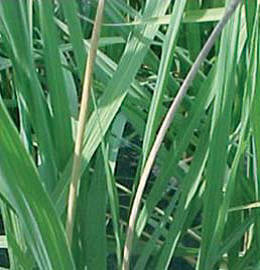 Fig 1.4 : Dead heart
Fig 1.4 : Dead heart  Fig 1.5 : White ear
Fig 1.5 : White ear
Management
Swarming caterpillar: Spodoptera mauritia
Symptoms of damage
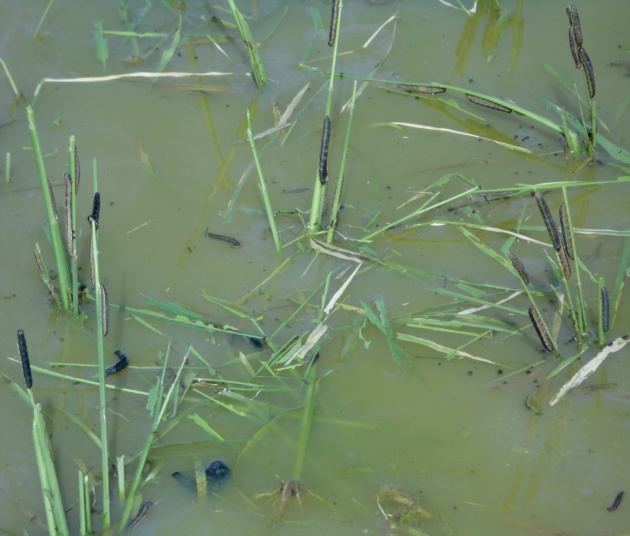 Fig 1.6
Fig 1.6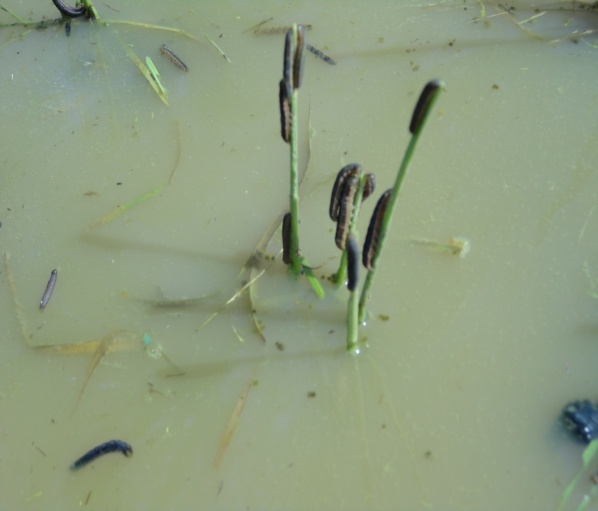 Fig 1.7
Fig 1.7
Management
Rice leaf folder Cnaphalocrocis medinalis
Symptoms of damage
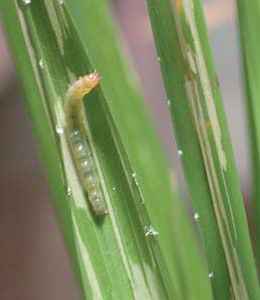 Fig. 1.8
Fig. 1.8 Fig. 1.9
Fig. 1.9
Management
Rice case worm Nymphula depunctalis
Symptoms of damage
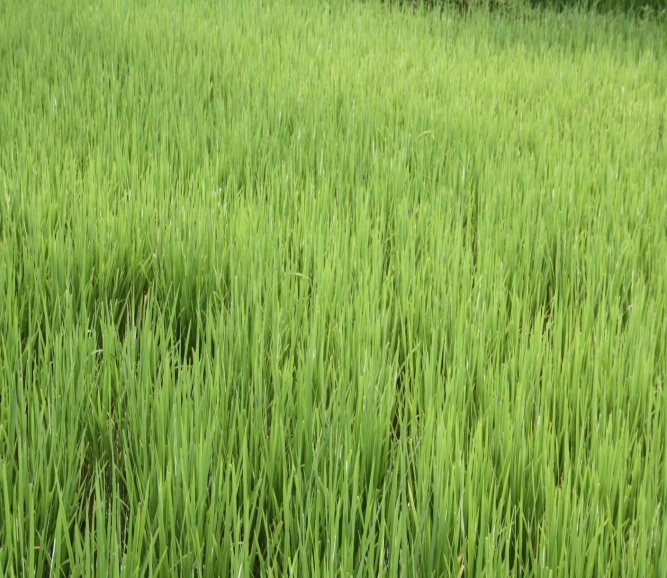 Fig 1.10
Fig 1.10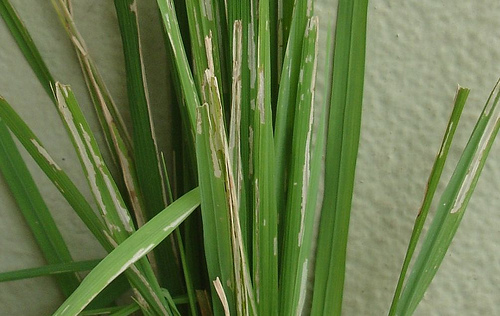 Fig 1.11
Fig 1.11
Management
Blast
Causal organism: Pyricularia grisea; Magnaporthe grisea (perfect stage)
 Fig 1.12
Fig 1.12 .jpg) Fig 1.13
Fig 1.13 .jpg) Fig 1.14
Fig 1.14
Symptoms of damage
Management
Brown spot (Sesame leaf spot)
Causal organism: Helminthosporium oryzae (Syn: Drechslera oryzae): Cochliobolus miyabeanus (perfect stage)
.jpg) Fig 1.15
Fig 1.15 .jpg) Fig 1.16
Fig 1.16
Symptoms of damage
Management
Sheath Rot
Causal organism: Sarocladium oryzae (Syn: Acrocylindrium oryzae)
 Fig 1.17
Fig 1.17
Symptoms of damage
Management
Sheath Blight
Causal organism: Rhizoctonia solani; Thanatephorus cucumeris (perfect stage)
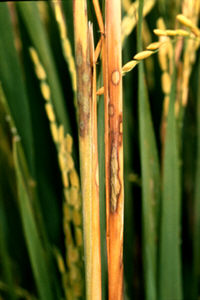 Fig 1.18 : Source : IRRI
Fig 1.18 : Source : IRRI
Symptoms of damage
Management
False smut
Causal organism: Ustilaginoidea virens; Claviceps oryzae-sativa (perfect stage)
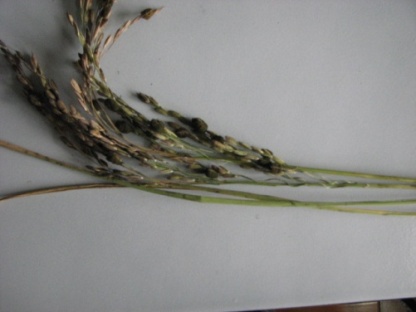 Fig 1.19
Fig 1.19  Fig 1.20
Fig 1.20  Fig 1.21
Fig 1.21
Symptoms of damage
Management
Bakanae disease
Causal organism: : Fusarium moniliforme; Gibberella fujikuroi (perfect stage)
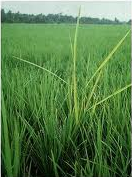 Fig 1.22
Fig 1.22 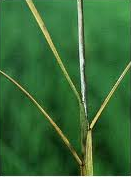 Fig 1.23
Fig 1.23
Symptoms of damage
Management
Bacterial leaf blight (BLB)
Causal organism: Xanthomonas oryzae pv. oryzae
.jpg) Fig 1.24
Fig 1.24 .jpg) Fig 1.25
Fig 1.25
Symptoms of damage
Management
Milling:
Modern rubberized mills or paddy rollers are effective to get higher milling efficiency. With parboiling, the milling recovery can further be improved.
Seeds
Machineries
